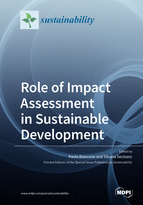Role of Impact Assessment in Sustainable Development
A special issue of Sustainability (ISSN 2071-1050). This special issue belongs to the section "Economic and Business Aspects of Sustainability".
Deadline for manuscript submissions: closed (31 December 2021) | Viewed by 52131
Special Issue Editors
Interests: accounting; accountability; social impact assessment; Islamic finance
Special Issues, Collections and Topics in MDPI journals
Interests: accounting; technologies; smart cities; accountability
Special Issues, Collections and Topics in MDPI journals
Special Issue Information
Dear Colleagues,
At a time of extreme difficulty for companies, there exists a wide range of studies and guidelines that invoke impact assessment as a driver for more sustainable development and effective resource planning.
The issue of sustainable development is determined not only by the effective use of resources and the application of appropriate strategies, but also by considering the social aspect as well. Thus, impact assessment has been established in companies with taking into consideration multiple criteria of different nature (economic, environmental, and social), as well as the transparency and engagement of the different stakeholders, such as organizations, government, and communities.
Several studies have highlighted the role of environmental and strategic impact assessment (EIA & SEA) as a facilitator of the evidence of climate change impacts within organizations. In the same way, social impact assessment (SIA) is a means of resilience in responding to change, to the needs of external stakeholders seeking to replace the contribution of public authorities, and therefore identifying opportunities that enhance benefits for local communities. The literature focuses extensively on both lines of research; however, few studies focus on how hybrid organizations, for example, can be involved in these processes.
Social impact and environmental impact have a reflection on economic aspects and are closely related to the complex reality in which hybrid organizations provide their services by focusing on both social impact and profit aspects by involving different sectors (i.e., public/private/third sectors in terms of governmental/profit/non-profit). Involvement of all of these could play a key role in promoting sustainable development through specific social, institutional, and technological innovations and practices.
This Special Issue aims to discuss the role of environmental and social impact assessment in companies in spheres such as profit and non-profit realities as a pathway for sustainable development as well as the role of hybrid organizations in the context of development and change. This Special Issue invites original research papers, case studies, reviews, and critical perspectives for current and new applied approaches also with an innovative vision.
Prof. Dr. Paolo BianconeProf. Dr. Silvana Secinaro
Guest Editors
Manuscript Submission Information
Manuscripts should be submitted online at www.mdpi.com by registering and logging in to this website. Once you are registered, click here to go to the submission form. Manuscripts can be submitted until the deadline. All submissions that pass pre-check are peer-reviewed. Accepted papers will be published continuously in the journal (as soon as accepted) and will be listed together on the special issue website. Research articles, review articles as well as short communications are invited. For planned papers, a title and short abstract (about 100 words) can be sent to the Editorial Office for announcement on this website.
Submitted manuscripts should not have been published previously, nor be under consideration for publication elsewhere (except conference proceedings papers). All manuscripts are thoroughly refereed through a single-blind peer-review process. A guide for authors and other relevant information for submission of manuscripts is available on the Instructions for Authors page. Sustainability is an international peer-reviewed open access semimonthly journal published by MDPI.
Please visit the Instructions for Authors page before submitting a manuscript. The Article Processing Charge (APC) for publication in this open access journal is 2400 CHF (Swiss Francs). Submitted papers should be well formatted and use good English. Authors may use MDPI's English editing service prior to publication or during author revisions.
Keywords
- social impact assessment
- environmental assessment
- impact assessment
- corporate development
- profit and non-profit sector
- sustainable development
Benefits of Publishing in a Special Issue
- Ease of navigation: Grouping papers by topic helps scholars navigate broad scope journals more efficiently.
- Greater discoverability: Special Issues support the reach and impact of scientific research. Articles in Special Issues are more discoverable and cited more frequently.
- Expansion of research network: Special Issues facilitate connections among authors, fostering scientific collaborations.
- External promotion: Articles in Special Issues are often promoted through the journal's social media, increasing their visibility.
- Reprint: MDPI Books provides the opportunity to republish successful Special Issues in book format, both online and in print.
Further information on MDPI's Special Issue policies can be found here.







